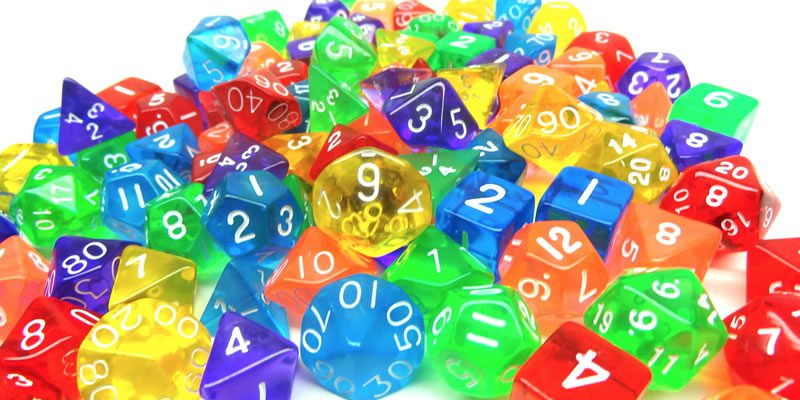Acronyphobia – Common Tabletop RPG Acronyms, Abbreviations & Terms

Acronyphobia is the irrational fear of acronyms. In tabletop RPGs we throw around a ton of acronyms and there is a bit of a learning curb for newbies. Even as experienced players we’re expected to just know all a ridiculous number of acronyms, abbreviations and terms. This week on the Campaign Trail I’ll try to make sense of these crazy acronyms, abbreviations & terms for new players and gamemasters (and for experienced players too afraid to ask). I tried to provide lots of dialog examples.
d% or d100
A percentile die roll, either by rolling a round 100-sided die or two 10-sided dice. These rolls are often used to determine a random effect of a player’s actions by looking up on a chart to handle anything from wild magic, carousing or even to see if a weapon breaks.
Bobby: If we have a couple of days downtime I want to hit the tavern!
Gamemaster: Bill, roll a d100.
Bobby: Which one is that?
Gamemaster: Just roll two d10s. Tell me the value of then in the order you roll them.
Bobby: 8 and 2.
Gamemaster: OK. That’s 82. Let me take a quick look.. OK, you had a good night. You did a little gambling at the Prancing Unicorn Tavern and walked away with 40 gold pieces.
Bobby: I am king of the world!
AC or Armor Class
AC is a number used to represent how difficult it is to hit a character/NPC. The number is made up of a combination of a creature’s attributes such as Dexterity, the hardness/coverage of their armor, any protection spells and even the natural toughness of their skin.
Armor Class: 11 + 3 = 14 AC
- Armor Base Value: 11 AC
- Player Character Dexterity: 16, modifier of +3
AoO/OA – Attack of Opportunity or Opportunity Attack
An Opportunity Attack is a special attack made by a character/NPC in reaction to some game event or character/NPC action. For example, when a player character chooses to run past another creature opening themselves up to an attack on the way by.
AoE – Area of Effect.
The Area of Effect is the specific area that an attack/spell/etc affects, often more than one creature or object usually in the shape of a sphere, cone or line.
BBEG – Big Bad Evil Guy
BBEG refers to the main antagonist or boss NPC for a particular adventure or campaign. He or she is the baddie pulling all the strings, acting as a foil, and generally just making life difficult for your player’s characters.
If you want to learn more about creating BBEGs and villains, check out my article on Adventure Building: Creating a Threat.
Crit – Critical Hit
A crit refers to a successful attack that causes greater than normal damage to the target and in some cases additional negative status or effect to the target. The most common crit is a roll of a 20 (or natural 20) on a twenty sided die. Certain weapons or classes often have larger crit ranges such as rolls of both 19 and 20. Usually a crit causes a target to receive double or maximum damage.
Cindy: I attack the goblin with my longsword. I roll a natural 20!
Gamemaster: Awesome. That’s a critical hit. We’re playing D&D 5e so roll your damage twice and then add your modifier.
Cindy: My longsword does 6 and 7 plus my strength modifier of 3 for 14 damage!
Gamemaster: You slash your longsword across the goblin’s midsection and he falls over dead as its insides are now outside.
Crunch
Crunch is used to describe the number heavy rules portion of a game, which detail the actual mechanics of how the game runs when dealing with abilities, statistics, monsters, equipment, etc. The opposite if Fluff.
DC – Difficulty Class
DC is the value used to measure how difficult a task that a player is attempting to complete. The DC is the number the player must meet or exceed (often a number of a die roll + modifiers) to be successful. Usually the harder the difficulty, the higher the DC.
Marcia: Guys, I’m strong, so I’m going to climb up the wall and sneak in through the window.
Gamemaster: The wall is pretty tall and flat. Roll me an Athletics check (looking for a roll higher than 15)
Marcia: I roll a 16. That’s pretty good I think.
Gamemaster: You manage to find some handholds between the stones and climb up the wall with only a little bit of a workout. You’re now under the window about the sneak in….
Dew
While tabletop gamers don’t exclusively drink Mountain Dew, any soda or beverage used during the game is often referred to as Dew. This term honors the disgusting amount of sugar and caffeine found in a bottle of the green elixir.
Dice Training
Some tabletop players believe that rolling dice repeatedly outside the game will change its statistical behavior. Superstitious players will often be heard saying they are “rolling out the 1s” or will even store dice with a favorable value (or the reverse) to “train” their the die to roll that number more (or less) frequently.
DM – Dungeon Master
See GM – Game Master
Dump Stat
A player stat (or statistic) with little or no perceived value to a player or group of player for a certain game. This dump stat is left at a low value intentionally in relation to the other stats.
Jan: Guys, this campaign is going to be all dungeon crawl. I’m making Charisma my dump stat and putting my stat points into making my Fighter strong and agile.
Fluff
Fluff is basically non-mechanic based material found in an RPG. Most often story based material designed to enhance role-playing. This material includes background information for NPC’s, and settings or even descriptive text for equipment or spells. Fluffy material is used to ‘flesh-out’ elements of a role-playing game so they appear in the mind’s eye as more than just a list of statistics. Opposite of Crunch.
Fumble
A “critical failure”, generally speaking a particularly bad result when attempting a particular action, usually brought about by a bad die roll or other randomizer. In game terms, results in worst possible outcome and usually involves rolling at 1 on a d20 (or nat 1).
GM – Game Master
In a tabletop RPG, the GM is the person at the table that runs the adventure versus playing a single player character. GMs introduces story elements (or hooks) for players to interact with and determine the outcome of actions and decisions by the players. The GM also runs also all of the NPCs. Some games can have more than one GM, but most games are run by a single person.
Grognard
A grognard is a term used to describe someone who enjoys playing war games or older versions of an RPGs even when a newer version is available.
Bobby: Alice is such a grognard, she only plays the original edition of Dungeons and Dragons. I wasn’t even born when that version came out.
Homebrew
An adaptation of a rule, class, race, monster, etc of a published RPG system by an amateur to be used in their home game or shared with other Gamemasters and players.
I couldn’t find a Raptor in the D&D 5th edition monster manual so I created my own homebrew Raptor based on Raptors released in previous rules and some of my own idea.
House Rule
A new or altered version of current rule used by a given group, usually a group of players who play at home or online in a private game versus organized play in a store or at a convention. These rules are not part of the published material for the game and highly encouraged by some rules (such as D&D 5th edition) to change the game to fit your groups play preferences.
HP or Hit Points
The number value used to track how much punishment a character can take in combat before collapsing (or even dying). Each hit that damages a PC will subtract from its HP total until a character reaches zero or lower.
Greg: If we have a couple of days downtime I want to hit the tavern!
Gamemaster: The goblin leader attacks your with her dogslicer. Does an attack roll of 18 hit against your AC?
Greg: Yes, my AC is only 16 right now, since I dropped my shield.
Gamemaster: The dogslicer’s crude edge slashes through your defence and hits you for 8 HP of damage.
Greg: Yikes. I just went from my max HP of 12 down to 4. I’m hurt pretty bad.
IC – In Character
The concept of talking in character, or in the 1st person, when describing the actions of your player character or talking to other players characters or NPCs in game. This style is generally preferred by most groups that enjoy the roleplaying aspect of a tabletop RPG.
Examples:
- Cindy: I run towards the ancient red dragon and attack.
- Peter: Shopkeep, do you have any magic rings that I might take a look at?
LBEG – Little Bad Evil Guy
Refers to an antagonist NPC meant to challenge the PC’s but is not the BBEG. (Often a lieutenant of the BBEG in a campaign).
LoE – Line of Effect
The term used to describe if an effect, (spell, attack, trap, moving object, etc), may affect something, (Another creature, object, location, etc.). Most often used to determine if something targeted may be affected by an effect.
LoS – Line of Sight
The term used to describe the ability of one creature to perceive something, (another creature, object, location, etc.), at any distance. Most often used to determine if something may be targeted.
Melee
Melee combat is basically hand-to-hand fighting using hand held weapons or to fight in close proximity. To fight from further away with weapons like bows is called ranged combat.
Metagame
Metagaming is when players discuss the rules or things their characters would not know versus roleplaying and keeping conversation in character and in-game.
Bobby: I run into the other room and heal Melkie.
Gamemaster: You are 100 feet down a hall in another room fighting in a loud battle. There is no way your character would know that Melkie just got hurt.
Cindy: I’m fine, don’t worry about me.
Gamemaster: Cindy, Melkie can’t talk to Grog.
Bobby: OK. I cast Thorn Whip and attack the goblin closest to me.
Min-max
Using the rules of the game to try and squeeze our any and every advantage for your character rather than designer a character to roleplay with strengths and flaws. Min-maxing often results in players that make no sense or are so powerful they leave the other players feeling left out of the game.
Multi-Class
To combine aspects from more than once class / role in a single character.
Cindy: Melkie and the group seem to be getting hurt a ton. I’d like to take a few levels in cleric.
Gamemaster: OK, sounds good. How are you going to handle it in game? We can do something like you receive a vision or a sign from the god you choose.
Natural #
The result of the actual dice roll, before any modifications are made. Example: a “natural 1” or a “natural 20” on a d20 are often considered “fumbles” or “criticals”. Often shortened to “nat 20” or “nat 1”.
Nerfing
To Nerf something is when an authority to the rules reduces the overall effectiveness of a particular ability or system. Nerfing is caused by a publisher revising rules or providing errata or a GM imposing house rules. Generally seen as a negative, but it can be used to create better balance in a system. Nerfing is a reference to Nerf® brand foam toys, designed for safety through use of soft foam.
NPC or Non-Player Character
Any creature in a game that is not controlled exclusively by a player. Most often run by the GM, but in some cases a player may determine actions of a Non-Player Character.
OOC – Out of Character
The concept of talking out of character, or in the 3rd person, when describing the actions of your player character or talking to other players characters or NPCs in game. This is generally less preferred by groups that enjoy the roleplaying aspect of a tabletop RPG. Some groups switch back and forth between talking in and out of character depending on the situation they are in.
Examples:
- Carol: I’m going to have Fizban run towards the ancient red dragon and attack with his magic staff.
- Alice: I ask the Sam the Butcher if he has seen anything strange happening in town.
PvP – Player vs Player
In some game, allowing players to attack each other directly. This should be handled pretty carefully if you allow it at all.
Railroading
To railroad is generally referred to when a game’s story is forced in a particular direction, most often by the GM, with little choice or agency by the players. Railroading is commonly perceived as bad form. A little railroading can create a more cinematic/plot driven game if that is what your players prefer versus a more sandbox game where the players explore and find the story on their own.
Save or Saving Throw
An attempt to avoid a detrimental effect, or success at such an attempt. Often phrased as “making a save” (though this can still refer either to the attempt or to success).
Gamemaster: The Mind Flayer looks at the two of you and you suddenly each feel a massive headache. Marcia and Jan, can you make me an Intelligence saving throw?
Marcia: I roll a 16.
Jan: I roll a 4. Why does Marcia always roll better. Marcia, Marcia, Marcia.
Gamemaster: Marcia, Treeroot is fine. Cindy, Melkie takes 22 points of psychic damage and she is stunned for 1 minute.
TPK – Total Party Kill.
A total party kill involved a combat or some other event where the entire group of player characters is killed.
Mike: This ancient red dragon sure caught us by surprise. I feel a TPK coming on. We only have 2 of us up still and our Cleric is dead.
Carol: If I’m going to die tonight, this dragon is coming with me. I’ll drag this dragon down to the Abyss with me if I have to.
XP – Experience Points
Awarded to players when they defeat a monster or overcome another type of challenge or obstacle. Experience points are accumulated and at certain amounts a player character will level up. An alternative to XP is to level at specific points in the story or after a certain number of game sessions.
Cindy: I can’t wait to get Melkie to level 5! I only need another 1,500 XP to get to 6,500 XP.
Let me know if there are any other obvious tabletop acronyms, abbreviations or terms I missed you’d like to see here. See you next week on the Campaign Trail.



